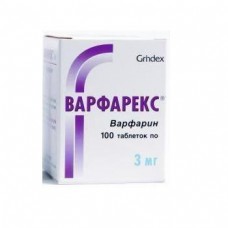Expiration date: 07/2026
The composition and form of issue:
Tablets. 1 tab. contains:
warfarin sodium (in the form of clathrate) and 3 mg
excipients: lactose, microcrystalline crospovidone magnesium stearate, dyes — Indigo
in plastic bottles to 30 or 100 PCs. in cardboard pack 1 bottle.
Pharmacokinetics:
The drug is a racemic mixture of stereoisomers, R and S. the S Stereoisomer of 2 to 5 times more active stereoisomer R, but its effect is shorter. Warfarex (warfarin) completely absorbed from the gastrointestinal tract. Cmax in the blood is achieved within 4 h after ingestion. Concentration in plasma is 1 to 5 µg/ml (of 0.003–0.015 mmol/l). Of proteins associated with blood by 97-99%. Warfarex (warfarin) undergoes chemical transformations in the liver, with the participation of the system of microsomal enzymes containing cytochrome P450 with the formation of inactive and active metabolites. Excreted mainly with urine (92% in the form of metabolites, the minimum of in an unmodified form) and in small quantities — in the bile. T1/2 after single oral — 20-60 (average 40) h
Significant changes in the pharmacokinetics of Warfarex (warfarin) in elderly patients is not observed. Found that the patients in this group are more sensitive to anticoagulants, however the nature of this phenomenon has not been elucidated. While liver synthesis of clotting factors reduced, and the metabolism of Warfarex (warfarin) slows down, which leads to increased inhibitory effect on blood clotting.
Description pharmacological action:
Warfarex belongs to the group of anticoagulants — drugs that prevent blood clotting, and is intended for long-term use. Has an indirect anticoagulant effects inhibiting liver synthesis of factors involved in the regulation of blood coagulation. Warfarex prevents formation of new clots and prevent growth of already formed.
Indications:
Prevention and treatment of diseases caused by blood clots in blood vessels:
- deep vein thrombosis
- thromboembolism of the lungs
- atrial fibrillation
- myocardial infarction
- prosthetic heart valves.
Contraindications:
- hypersensitivity to the drug
- bleeding (or the threat of their development) in some severe diseases
- bacterial endocarditis
- severe failure and severe liver disease or kidney
- obstructive jaundice
- diabetes
- acute DIC
- deficiency of proteins C and S
- hemorrhagic diathesis
- thrombocytopenia
- ulcers disease stomach and duodenal ulcer in the acute stage
- bleeding in the brain
- alcoholism
- severe arterial hypertension
- recent or anticipated complex surgery and diagnostic procedures
- inadequate assessment of blood coagulation by laboratory methods
- the children's age.
Application of pregnancy and breast-feeding:
Warfarex should not be administered to pregnant women in connection with the revealed teratogenic, development of bleeding in the fetus and its death.
The drug is excreted in breast milk in small amounts and has little to no effect on blood coagulation in a child, so this medication can be used during lactation, however, it is advisable to refrain from breastfeeding in the first 3 days of therapy with warfarin.
Side effects:
The most frequent side effects observed during treatment with anticoagulants are bleeding and hemorrhage in various organs and tissues. The possible risk of these side effects can be reduced significantly by strictly following the doctor's recommendation relating to the admission of Warfarex.
In some cases, treatment with anticoagulants can cause poor circulation in the extremities or internal organs. About the blood circulation often shows pain and dark red leather toes. If you have these symptoms you should immediately consult a doctor.
Other rare side effects are allergic skin reactions (itching, urticaria, dermatitis), nausea, vomiting, diarrhea, abdominal pain, impaired activity of the liver (increase in liver enzymes in the blood, jaundice), fever, General weakness, changes in the blood picture, alopecia transient.
Drug interactions:
High content of vitamin K in foods (spinach, broccoli, lettuce and other leafy vegetables) may reduce the effect of Warfarex. However, you should not change the diet too fast, use vitamins and nutritional supplements without consulting a doctor.
Smoking can reduce the anticoagulant effect of the drug.
The effect of Warfarex can change under the influence of a large number of drugs.
NSAIDs, dipyridamole, valproic acid, inhibitors of cytochrome P450, cimetidine, chloramphenicol, laxatives — increase the risk of bleeding. Avoid concomitant use of these drugs and Warfarex (cimetidine can be replaced with ranitidine or famotidine). If necessary, treatment with chloramphenicol anticoagulant therapy may be temporarily discontinued. Diuretics can reduce the effects of anticoagulants (in the case of hypovolemic Express actions, which may lead to increased concentration of clotting factors). Weaken the effect: barbiturates, vitamin K, glutetimid, griseofulvin, dicloxacillin, carbamazepine, mianserin, paracetamol, retinoid, rifampicin, sucralfate, phenazone, cholestyramine. Enhance the effect: allopurinol, amiodarone, anabolic steroids (alkylated at position C-17), acetylsalicylic acid and other NSAIDs, heparin, glibenclamide, glucagon, danazol, diazoxide, disopyramide, disulfiram, isoniazid, ketoconazole, clarithromycin, clofibrate, levamisole, metronidazole, miconazole, nalidixic acid, nilutamide, omeprazole, paroxetine, proguanil, oral hypoglycemic agent — derivatives of sulfonamides, sulfonamides, tamoxifen, thyroxine, quinine, quinidine, fluvoxamine, fluconazole, fluorouracil, chinolone, chloral hydrate, chloramphenicol, cephalosporins, cimetidine, erythromycin, ethacrynic acid, ethanol. When using Warfarex in combination with the above drugs is necessary to monitor INR at the beginning and end of the treatment and, if possible, 2-3 weeks from start of therapy. When using drugs that may increase the risk of bleeding due to the decrease in the normal coagulation (inhibition of blood clotting factors or liver enzymes), strategy, anticoagulant therapy should be determined by possibility of carrying out of laboratory control. If possible frequent laboratory monitoring, when necessary, treatment such means the dose of Warfarex can be reduced 5-10%. If laboratory control is difficult, the treatment Warfarex need to stop, if necessary, the appointment of these drugs.
Method of application and dose:
Inside, 1 times a day, preferably at the same time. Dose, mode and duration of application of Warfarex doctor determines for each patient individually, guided by the severity of the disease and results of the control of blood coagulation (INR). Without a doctor can not arbitrarily change the dose or stop treatment with Warfarex.
Initial dose 2.5–5 mg per day in the first 2 days, then gradually adjust in accordance with the individual response of blood clotting of the patient (INR). After achieving the desired level of INR (2.0 to 3.0, and in some cases to 3.0–4.5) prescribe a maintenance dose.
Elderly, weak or at-risk patients are prescribed a lower starting dose and cautious in their increase. Children Warfarex is not usually prescribed.
At the beginning of treatment laboratory control of INR is carried out every day for the next 3-4 weeks control is carried out 1-2 times a week, and later every 1-4 weeks. More frequent additional monitoring is required in cases when the health of the patient before the scheduled surgery or other procedure, as well as when to prescribe or cancel any other drug.
Overdose:
Symptoms of chronic intoxication: bleeding from gums, nosebleeds, excessive menstrual bleeding, severe or prolonged bleeding from small surface injuries, bleeding in the skin, presence of blood in the urine and feces, etc.
Treatment: for minor bleeding, reduce dose or stop treatment for a short period. In case of severe bleeding, transfusion of factor concentrates prothrombin complex or fresh frozen plasma, or whole blood.
Special instructions:
The use of anticoagulants increases the risk of bleeding. To monitor blood coagulation during treatment with Warfarex should regularly visit a doctor and carry out the necessary tests.
When referring to doctors, dentists or pharmacists are required to inform them that You are taking Warfarex.
You should consult a doctor, if there are digestive disorders accompanied by diarrhoea (diarrhea), fever.
Pregnancy during treatment with Warfarex very undesirable, so you need to use effective methods of preventing it.
You must be careful when handling sharp and traumatic objects, to avoid activities associated with the risk of injury and subsequent bleeding.
During treatment should refrain from the use of ethanol (the risk gipoprotrombinemii).
The safety of the drug in children in clinical trials has not been studied.
Data regarding the adverse impact of Warfarex on the ability to drive vehicles and maintain other mechanism.
Patients with lactose intolerance should be borne in mind that 1 table. Warfarex 106-112 contains mg lactose.



